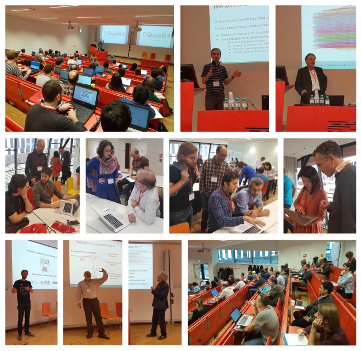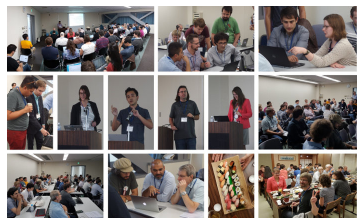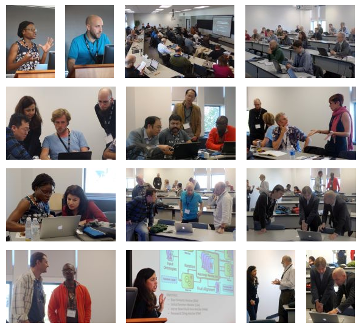Visualization and Interaction for Ontologies and Linked Data
4th International Workshop co-located with ISWC 2018, October 8, 2018, Monterey, CA, USA

Announcement: VOILA 2019
VOILA! will take place again at ISWC 2019. Details can be found on the VOILA 2019 workshop website.
Motivation and Objectives
A picture is worth a thousand words, we often say, yet many areas are in demand of sophisticated visualization techniques, and the Semantic Web is not an exception. The size and complexity of ontologies and Linked Data in the Semantic Web constantly grows and the diverse backgrounds of the users and application areas multiply at the same time. Providing users with visual representations and intuitive interaction techniques can significantly aid the exploration and understanding of the domains and knowledge represented by ontologies and Linked Data.
Ontology visualization is not a new topic and a number of approaches have become available in recent years, with some being already well-established, particularly in the field of ontology modeling. In other areas of ontology engineering, such as ontology alignment and debugging, although several tools have been developed, few provide a graphical user interface, not to mention navigational aids or comprehensive visualization and interaction techniques.
In the presence of a huge network of interconnected resources, one of the challenges faced by the Linked Data community is the visualization of multidimensional datasets to provide for efficient overview, exploration and querying tasks, to mention just a few. With the focus shifting from a Web of Documents to a Web of Data, changes in the interaction paradigms are in demand as well. Novel approaches also need to take into consideration the technological challenges and opportunities given by new interaction contexts, ranging from mobile, touch, and gesture interaction to visualizations on large displays, and encompassing highly responsive web applications.
There is no one-size-fits-all solution but different use cases demand different visualization and interaction techniques. Ultimately, providing better user interfaces, visual representations and interaction techniques will foster user engagement and likely lead to higher quality results in different applications employing ontologies and proliferate the consumption of Linked Data.
Program
The workshop will take place at the Asilomar Conference Grounds in the meeting room Evergreen (located at the very top, in the F1 square on the venue map). The registration desk is located in the back of Merrill Hall (see G4 on the venue map).
9:00 - 9:15 Opening
9:15 - 10:30 Session I: Introduction into the Workshop Topic & Special Theme
9:15 - 9:45 Ontology Visualization Methods and Tools: a Survey of the State of the Art
by Marek Dudáš, Steffen Lohmann, Vojtěch Svátek, and Dmitry Pavlov [Slides]
9:45 - 10:10 Conducting and Reporting on Empirical User Studies in Semantic Web Contexts
by Catia Pesquita, Valentina Ivanova, Steffen Lohmann and Patrick Lambrix
Until 10:30 Discussion
10:30 - 11:00 Coffee break
11:00 - 12:20 Session II: Visualizations & User Interfaces
11:00 - 11:20 Graphless: Using Statistical Analysis and Heuristics for Visualizing Large Datasets
by Idafen Santana-Perez [Slides]
11:20 - 11:40 Towards a Uniform User Interface for Editing Data Shapes
by Ben De Meester, Pieter Heyvaert, Anastasia Dimou and Ruben Verborgh [Slides]
11:40 - 12:00 A Comparative User Evaluation on Visual Ontology Modeling using Node-Link Diagrams
by Vitalis Wiens and Steffen Lohmann
until 12:20 Discussion & Wrap-Up Morning
12:20 - 14:00 Lunch
14:00 - 15:30 Session III: Visual SPARQL Querying & Linked Data Exploration
14:00 - 14:20 WiSP: Weighted Shortest Paths for RDF Graphs
by Gonzalo Tartari and Aidan Hogan [Slides]
14:20 - 14:40 Combining Faceted Search with Data-analytic Visualizations on Top of a SPARQL Endpoint
by Petri Leskinen, Goki Miyakita, Mikko Koho and Eero Hyvönen [Slides]
14:40 - 14:55 Sparqling: Painlessly Drawing SPARQL Queries over Graphol Ontologies
by Sara Di Bartolomeo, Gianluca Pepe, Domenico Fabio Savo and Valerio Santarelli [Slides]
14:55 - 15:10 Dataset Dashboard - a SPARQL Endpoint Explorer
by Petr Křemen, Lama Saeeda, Miroslav Blaško and Michal Med [Slides]
until 15:30 Discussion
15:30 - 16:00 Coffee break
16:00 - 16:45 Session IV: Demo Jam (break-outs)
by ALL: Everyone is invited to show a demo related to the workshop topic.
Demos: (registered so far) - Different room: Nautilus !!!
- Graphless - Idafen Santana-Perez
- unSHACLED - Ben De Meester
- WebVOWL Editor - Vitalis Wiens
- Matey - Anastasia Dimou
- Mobi - Megan Mercer
- Gra.fo - Juan Sequeda
- WiSP - Aidan Hogan
- Sparqling - Domenico Fabio Savo
- SemSpect - Thorsten Liebig
16:45 - 17:00 Wrap Up & Closing
Impressions
About 40 researchers and practitioners took part in the full-day event consisting of talks, discussions, and tool demonstrations. Here are some impressions from the workshop:
Proceedings
The workshop proceedings are published as CEUR-WS volume 2187.
V. Ivanova, P. Lambrix, S. Lohmann, C. Pesquita: Proceedings of the Fourth International Workshop on Visualization and Interaction for Ontologies and Linked Data (VOILA '18), Monterey, CA, USA. CEUR Workshop Proceedings, vol. 2187, CEUR-WS.org, 2018.
Special Theme & Topics of Interest
This year, we plan to have a dedicated look on empirical evidence on the benefits and limitations of visualizations and interactions in the context of the Semantic Web. We are particularly interested in success and failure stories, in learning which visualization and interaction approaches work and which do not - to which extent and in which contexts. We would like to hear about novel research findings and insights, backed with empirical data from user studies and use cases. Submissions addressing this special theme could include one or more of the following:
- success stories
- failure stories
- empirical studies
We also welcome other research contributions providing empirical evidence that advances the field.
Apart from that - and as in the last years -, we are looking for submissions addressing one or more of the following topics, subjects, and contexts (or related ones):
- Topics:
- visualizations
- user interfaces
- visual analytics
- requirements analysis
- case studies
- user evaluations
- cognitive aspects
- Subjects:
- ontologies
- linked data
- ontology engineering (development, collaboration, ontology design patterns, alignment, debugging, evolution, provenance, etc.)
- Contexts:
- classical interaction contexts (desktop, keyboard, mouse, etc.)
- novel interaction contexts (mobile, touch, gesture, etc.)
- special settings (large, high-resolution, and multiple displays, etc.)
- specific user groups and needs (people with disabilities, domain experts, etc.)
Submission Guidelines
Paper submission and reviewing for this workshop will be electronic via EasyChair. The papers should be written in English, following the Springer LNCS format, and be submitted in either PDF or in HTML on or before June 8, 2018 (extended). Abstracts are due on on or before June 3, 2018 (extended). All deadlines are midnight Hawaii time.
For details on the PDF submission format, see Springer's LNCS guidelines. For HTML submission guidance, see the HTML submission guide of ISWC 2018.
The following types of contributions are welcome. The recommended page length is given in brackets. There is no strict page limit but the length of a paper should be commensurate with its contribution.
- Full research papers (8-12 pages);
- Experience papers (8-12 pages);
- Position papers (6-8 pages);
- Short research papers (4-6 pages);
- System papers (4-6 pages).
It is recommended to include a (persistent) URL to a working implementation or an (annotated) screencast for submissions presenting interactive visualizations, user interfaces, tools, etc.
Accepted papers will be published as a volume in the CEUR Workshop Proceedings series. See CEUR-WS volume 1947 for the proceedings of last year's VOILA workshop.
Note that for the second time this year ISWC offers a registration *only* for the workshops and tutorials days. For details please visit the ISWC registration page.
Organizers
Patrick Lambrix, Linköping University, Sweden
Steffen Lohmann, Fraunhofer IAIS, Germany
Catia Pesquita, University of Lisbon, Portugal
Programme Committee
Nikos Bikakis, ATHENA Research Center, Greece
Kārlis Čerāns, University of Latvia, Latvia
Isabel F. Cruz, University of Illinois at Chicago, USA
Aba-Sah Dadzie, Open University, UK
Aidan Delaney, University of Brighton, UK
Marek Dudáš, University of Economics, Czech Republic
Roberto García, Universitat de Lleida, Spain
Alain Giboin, Université Côte d'Azur, Inria, CNRS, I3S, France
Anika Groß, University of Leipzig, Germany
Ali Hasnain, Insight Centre for Data Analytics, Ireland
Eero Hyvönen, Aalto University & University of Helsinki, Finland
Ali Khalili, Vrije Universiteit Amsterdam, The Netherlands
Paul Parsons, Purdue University, USA
Silvio Peroni, University of Bologna, Italy
Emmanuel Pietriga, INRIA Saclay, France
Harald Sack, Leibniz Institute for Information Infrastructure & KIT Karlsruhe, Germany
Daniel Schwabe, Pontifical Catholic University of Rio de Janeiro, Brazil
Kamran Sedig, University of Western Ontario, Canada
Ahmet Soylu, Norwegian University of Science and Technology, Norway
Gem Stapleton, University of Brighton, UK
Markel Vigo, University of Manchester, UK
Important Dates
Abstract: June 3, 2018 (extended)Submission: June 8, 2018 (extended)Notification: June 27, 2018Camera-ready: July 20, 2018Workshop: October 8, 2018






